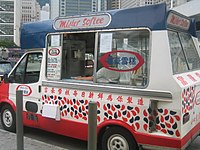Portal:Hong Kong/Selected article/2008
These articles have appeared on the Portal:Hong Kong page in 2008.
January

Happy Valley Racecourse is one of the two racecourses for horse racing in Hong Kong. It is located in Happy Valley on Hong Kong Island, surrounded by Wong Nai Chung Road and Morrison Hill Road. It was first built in 1845 to provide horse racing for the British people in Hong Kong. Before it was built, the area was a swampland, but also the only flat ground suitable for horse racing on Hong Kong Island. On 26 February 1918 a fire broke out with at least 590 people dead.
February

Mister Softee is a United States Ice-cream franchise that is also popular in Hong Kong. Locally owned by the Ng Enterprises Ltd., it consists of a number of ice cream trucks. As the Hong Kong Government has stopped the issue of new hawking licenses since 1978, and the existing licenses cannot be transferred to other vehicles, the old trucks are still running on the roads of Hong Kong. Each van, as required by the law, comprises a soft ice cream making machine, a basin, and two refrigerators.
The red-white-blue outlook of the trucks, and the Blue Danube played by them, are part of the collective memory of many Hong Kongers. The first truck, which had been imported from England, began to operate in 1970. Today the company has 14 ice cream vans running on Hong Kong Island, Kowloon and the New Territories. The headquarters of the company is located in Fo Tan.
March

The Hong Kong Museum of Coastal Defence is a museum in Hong Kong, located at Lei Yue Mun near Shau Kei Wan on Hong Kong Island.
The total area of the museum is 34,200 square metres. An exhibition entitled "600 years of Coastal Defence" is held permanently in the museum.
The museum was built as a fort by the British in 1887. It was originally built for coastal defence, especially for the east Victoria Harbour, but nowadays it is an exhibition centre. Inside there are castle, defence basement, military vehicle and gun display etc.
April

Golden Beach is located at the 18.5 km milestone of Castle Peak Road, Tuen Mun. It is the largest beach in Tuen Mun with a total area of 78,500 m² and a length of 545 meters. It is the first artificial beach in Hong Kong. It is classified as a Grade 2 beach, meaning that the water quality is fair. Refreshment kiosks, a hotel and a shopping mall are to be found adjacent to the beach.
Golden Beach is unique amongst the beaches of Hong Kong in that it has a volleyball court. The Hong Kong Beach Volleyball Team occasionally practises on Golden Beach.
May

The Hong Kong Visual Arts Centre is located in Hong Kong Park, at Kennedy Road in Central, Hong Kong Island, Hong Kong. According to the Plaque in the Arts Centre, it was opened by Leung Ding-Bon, the then chairman of the Urban Council in 1992.
The main aim of the centre is to support the local art creation. The centre was restructured from an early 20th century building (Cassels Block, former barracks for married British officers, of Victoria Barracks), in order to provide an area and facilities for local artists in order to enhance their creativity. A lot of modern artifacts and sculptures can be enjoyed in this centre.
June
Stone wall trees in Hong Kong refer to trees grown from openings in masonry stone retaining walls. In alleviating hazards from landslides, many slopes adjacent to main roads and developments on Hong Kong Island in Hong Kong needed to be secured. Between the 19th century and World War II, the Hong Kong Government and other contractors constructed masonry stone walls to prevent these hazards.
July
Portal:Hong Kong/Selected article/2008/July
August

Mass Transit Railway or MTR (地下鐵路, literally "underground railway"; usually abbreviated to 地鐵 or 地下鐵) is the main rapid transit railway system in Hong Kong. Since the MTR service first opened in 1979, the network has expanded to encompass seven lines and 53 stations along 91.0 km [1]. Constructed and operated by MTR Corporation Limited, the MTR system is a very popular mode of public transport in Hong Kong, with an average of 2.46 million[2] journeys recorded each day.
Much of this popularity is due to the efficiency and affordability of the MTR. For example, a taxi ride from Tsing Yi in the New Territories to Causeway Bay on Hong Kong Island costs around HK$200, while the same trip on the MTR costs HK$11.80, and HK$5.70 on concessionary fare.[3] The integration of the Octopus contactless smart card system into the MTR system in September 1997 has particularly enhanced the ease of use of the MTR.
Construction of the MTR was prompted by a government-commissioned study released in 1967. The Hong Kong Government commissioned the study in the 1960s to find solutions to the growing traffic problem caused by expansion of the colony's economy.[4] Construction started soon after release of the study, and the first line was opened in 1979. The MTR was immediately popular with the residents of Hong Kong, and as a result subsequent lines have been built to cover more territory. There are continuing debates as to how and where to expand the MTR network, including new lines and a possible merger with Kowloon-Canton Railway Corporation to create a combined network. (Read more...)
September
Portal:Hong Kong/Selected article/2008/September
October
Portal:Hong Kong/Selected article/2008/October
November
Portal:Hong Kong/Selected article/2008/November
December
Portal:Hong Kong/Selected article/2008/December
- ^ "Mass Transit Railway", Transport Department (Hong Kong Government), retrieved 16 March 2006
- ^ "MTR Patronage Figures for February 2006", MTR Corporation Limited, retrieved 16 March 2006
- ^ Based on "MTR Journey Planner", MTR Corporation Limited, retrieved 16 March 2006.
- ^ Freeman, Fox, Wilbur Smith & Associates (1967), Hong Kong Mass Transport Study, as shown in map above mentioned.
